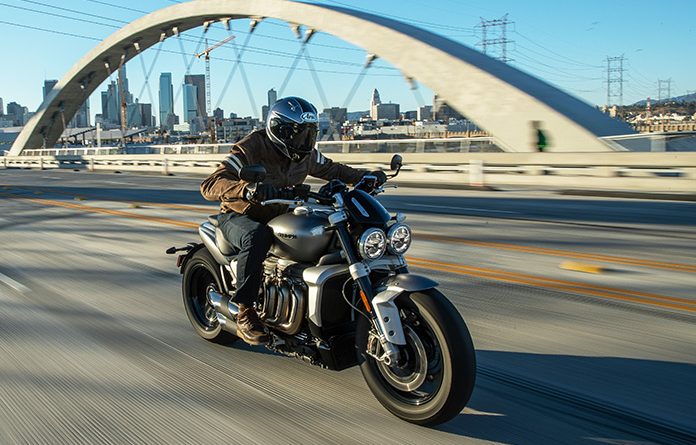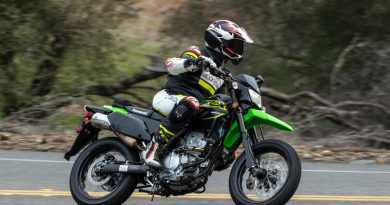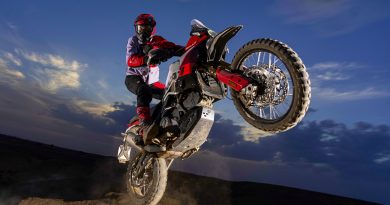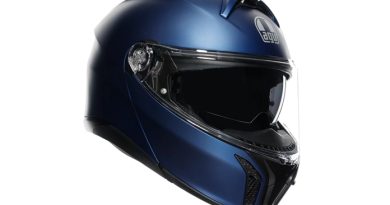2023 Triumph Rocket 3 R | Road Test Review
The 2023 Triumph Rocket 3 R felt
right at home on
the mean streets of
downtown Los Angeles. (Photos by Kevin Wing)
The first thing you need to know about the Triumph Rocket 3 R is that its inline-Triple displaces 2,458cc (150ci), making it the largest motorcycle production engine by far. Nothing else even comes close.
The Rocket 3 R’s cylinders are like a hippopotamus’ teeth: It doesn’t have many, but the ones it does have are impressive. They have a bore of 4.33 inches – wider than the cylinders in a 707-hp Dodge Hellcat – and a stroke of 3.4 inches. Each one displaces 819.3cc, exceeding the engine capacity of Triumph’s Street Triple 765 sportbike.
Related: 2024 Triumph Street Triple 765 Range | First Look Review
Claimed output at the crank is 165 hp and 163 lb-ft of torque. You can buy a sportbike tuned to make more horsepower, but no production motorcycle churns out as much grunt. Again, nothing else comes close.
The second thing you need to know is that, despite having such an enormous engine, the Rocket 3 R is not an overweight, bloated machine. With a claimed dry weight of 641 lb and an estimated curb weight approaching 700 lb, it’s as light or lighter than many cruisers and open-class sport-tourers.
Even taking its engine size and output into account, the Rocket 3 R remains a rare breed: a muscle cruiser that handles well and has sportbike-caliber components and electronics. And its design, from its mix of brushed, matte, and gloss finishes to its single-sided swingarm, exhibits incredible attention to detail and top-notch fit and finish.
My, How You’ve Grown
Midmount controls and minimal handlebar pullback encourage an
aggressive posture, especially when on
the gas.
In the late ’90s and early 2000s, there was a displacement war going on among cruisers, with engine sizes growing from 1,449cc on the Harley-Davidson Twin Cam 88 to 1,510cc on the Victory 92C. Then the Japanese OEMs joined the fray, starting with 1,670cc on the Yamaha Road Star, then 1,795cc on the Honda VTX1800, and finally, breaking the two-liter barrier, 2,053cc on the Kawasaki Vulcan 2000, which debuted for 2004.
The following year, Triumph came along and topped them all with the Rocket III, which got its thrust from a massive 2,294cc inline-Triple, albeit with an extra cylinder compared to the V-Twins listed above. The Rocket III was under development in the early 2000s, and with each new displacement benchmark, Triumph’s engineers ratcheted up the engine’s capacity because the company’s primary goal was to be the biggest.
Related: 2014 Triumph Rocket III Touring | Road Test Review
The three-cylinder configuration made sense because the modern incarnation of Triumph, under the direction of John Bloor, had built its reputation and brand image around Triples in bikes like the Trophy, Sprint, and Speed Triple. But the origins of the Triple and the model name came from even further back in Triumph’s history: The 1968 Triumph Trident / BSA Rocket III (the same bike with different badging during a time when both brands were under the same umbrella) was the first three-cylinder motorcycle produced by the British manufacturer. Since the modern Rocket III’s engine would be so large, Triumph arranged its cylinders longitudinally rather than transverse to the direction of travel, as on its other Triples.
It’s been nearly a decade since we tested the Rocket III Touring, which was a conventionally styled cruiser with a single round headlight, driving lights, a buckhorn handlebar, top-loading saddlebags, a passenger backrest, and lots of chrome. At 105 hp and 150 lb-ft of torque, it also had a milder state of tune than the Rocket III Roadster, which made 146 hp and 163 lb-ft of torque at the crank. Both bikes were enormous, scaling in at 906 lb for the Touring and 806 lb for the Roadster.
For the 2020 model year, Triumph hit the reset button. It changed the platform’s name to Rocket 3, favoring the more common and contemporary Arabic numeral to its antiquated Roman counterpart. While that may seem like a quibbling distinction, it represented Triumph’s commitment to building a more modern machine. The engine not only grew from 2,294cc to 2,458cc, it was updated with a new crankcase assembly, balancer shafts, and lubrication system. The Rocket 3 was also equipped with throttle-by-wire, an IMU, ride modes, cornering-optimized ABS and traction control, cruise control, hill-hold control, and keyless ignition.
Compared to the previous platform, the Rocket 3 had gone on a crash diet, shaving off roughly 90 lb. Even though the new engine has more displacement, it is 40 lb lighter than its predecessor. More weight was saved by replacing the steel frame and swingarm with cast-aluminum units, lightening the exhaust system and wheels, and reducing fuel capacity from 6.3 gallons on the RIII Roadster and 5.9 gallons on the RIII Touring to 5 gallons on the Rocket 3.
There are two versions of the Rocket 3: the R roadster tested here, which starts at $23,895, and the GT tourer with a small windscreen, more handlebar pullback, forward foot controls, and a passenger backrest, which starts at $24,595. Triumph also produces some limited-edition versions with special paint, finishes, and details, including the Rocket 3 R 221 Special Edition (which celebrates its 221 Newton-meters of torque), the Rocket 3 R Chrome Edition, and the Rocket 3 GT Chrome Edition.
See all of Rider‘s Triumph coverage here.
Triumph Rocket 3 R: A Beauty and A Beast
Even though the old Rocket III made boatloads of torque, its styling was bland. Its mondo engine, enormous radiator, and 240mm rear tire gave it big-boy presence, but little about the Rocket III said, “Hey, look at me!” A cruiser should not only make generous low-end torque, it should also make a statement, and the Rocket 3 R certainly does that.
It’s a muscle bike with a muscular stance, sitting on fat tires – 150/80-17 up front, 240/50-16 out back – and covered in a wide array of metallic surfaces, as if the entire bike were carved from one big block of metal. The effect is even more pronounced with the Matte Silver Ice paint on our test bike (other color options are Sapphire Black, Phantom Black, Korosi Red, or Silver Ice/Cranberry Red). On the right side is a stunning hydroformed triple-exhaust header that ends in short, matte-black silencers with slash-cut chrome end caps – two on the right side and one on the left.
There is nothing clunky or out of place – no unsightly hoses or wires, no half-baked compromises. The “Rocket 3 R” and “2500 cc” badges are engraved; the matching fuel, radiator, and oil filler caps are brushed aluminum; and even the bar-ends have custom detailing. The coolest styling element, and the one I bragged about to everyone that asked about the bike (it’s a lookie-loo magnet), are the double-hinged, fold-away passenger pegs.
If there’s one thing that looks a little off to me, it’s the dual round headlights. They’ve been a signature Triumph styling element since the ’90s, most notably on the Speed Triple, and they were on the Rocket III Roadster. But with the more modern look of the Rocket 3 R, just as Triumph did with the Speed Triple about a decade ago, evolving the headlights into a more aggressive shape would make the bike’s overall appearance more cohesive.
Complementing the raw metallic look of the many brushed and polished surfaces
are black finishes on the flyscreen, handlebar, fork tubes, and side covers.
Hitting the starter button on the Rocket 3 R elicits an authoritative growl, and blipping the throttle at idle causes the entire bike to twist to the right due to its big, longitudinal crankshaft. Perhaps to make the bike more livable, throttle response is a tad dull below 2,000 rpm, but once the big pistons spin up more, the well of grunt feels bottomless. On Jett Tuning’s dyno, the 2.5-liter beast spun the drum to a peak of 148 lb-ft of rear-wheel torque at 3,900 rpm, with more than 140 lb-ft on tap between 2,500 rpm and 5,300 rpm (redline is 6,500). There’s hardly a ripple in either the torque or horsepower curves, with the latter climbing steadily from 47 hp at 2,000 rpm to a peak of 145 at 6,100 rpm. Power is sent to the rear wheel through an enormous driveshaft.
While the 6-speed transmission with torque-assist clutch shifts cleanly without any big cruiser clunkiness, this is not a bike that requires much rowing through the gearbox. Short shift your way up to top gear, and the big mill spins only about 3,200 rpm at 75 mph. On a twisty backroad, just put it in 3rd and forget about it – there’s always enough grunt to pull you out of corner and catapult you toward the next one. And when a long straight stretch opens up, grab a handful and hang on – it’s an experience you won’t soon forget and will be eager to repeat.
Twin round headlights
are a Triumph hallmark, and all
lighting is LED.
The Rocket 3 R is the physical embodiment of badassery. Until you beep the horn. Then it sounds like a Vespa. Even by motorcycle standards, the horn is wimpy.
As shown in other photos, the double-hinged passenger
pegs fold away completely.
The Triumph Rocket 3 Can Bend It Like Beckham
Motorcycles with ultra-wide 240mm rear tires aren’t typically known for their cornering prowess because it takes effort to get the bike over onto the side of the tire. But Triumph worked with Avon to develop the profile of the Rocket 3 R’s Cobra Chrome tires to ensure their profiles resulted in fairly neutral handling. For a big, long bike, the R3R goes around corners remarkably well, requiring less steering effort than one might expect.
The Rocket 3 R is one of those rare
cruisers – Triumph prefers to call it a roadster – where
cornering clearance isn’t a major limitation.
Helpful in this respect is adjustable Showa suspension with damping that’s more sporting firm than touring soft. There’s enough suspension travel to absorb the worst of big hits, but ride quality generally favors smooth roads over bumpy ones. Slowing things down is a trio of top-shelf Brembo Stylema 4-piston radial monoblock calipers – two in front pinching 320mm discs and one out back pinching a 300mm disc – with hydraulic fluid pumped through steel-braided lines. They’re serious anchors that offer outstanding stopping power with precise feel at the lever.
Nicely rounded profiles on the fat tires give the Rocket 3 R good cornering
manners, but WFO in a straight line is where the real magic happens.
Gear Up:
Helmet: Arai Defiant-X
Jacket: Joe Rocket Classic ’92
Gloves: Joe Rocket Cafe Racer
Pants: Scorpion Covert Ultra Jeans
Boots: Fly Racing Tradesman
Deux Ex Machina
When the Rocket 3 R is keyed on, its color TFT display shows the Triumph logo and a message that says, “Welcome Rider.” Always puts a smile on my face.
Bar-end mirrors add to the Rocket 3 R’s go-fast look. The shapely seamless gas
tank is topped with a brushed-aluminum strap.
I parked the Triumph in the garage at LAX airport during a short trip, and when I returned, I pulled the keyless fob out of my backpack and pressed the bike’s power button. A small red light came on, which means the fob isn’t within range or isn’t working. It was 11 p.m. and raining, and I still had an hour’s ride ahead of me. I held the fob close to the bike and pressed the power button again and again, but no luck.
As panic started to set in, I imagined the Rocket 3 R as HAL 9000 from 2001: A Space Odyssey: “I’m sorry, Greg, but I’m afraid I can’t do that.”
Our all-silver test bike matches the stainless-steel panels of the Frank Gehry-
designed Walt Disney Concert Hall.
Turns out I’m a moron. What I didn’t know is that, to save its battery, the fob goes to sleep. And to wake it up, you must press a button on the fob. But there’s not an obvious button, just an embossed Triumph logo.
During my Uber ride home, I sent a grumpy email to Adam VanderVeen, Triumph America’s marketing director, asking for help. I’m sure he laughed to himself as he composed a diplomatic reply informing me that, in fact, the logo is the button, and when you press it, a green light comes on to let you know the fob is sending signals to the bike.
Top-shelf Brembo Stylema calipers front and rear are serious
anchors.
After bumming a ride back to LAX the next day, I pressed the logo-button-thingy, and the Rocket 3 R powered right up. I was relieved that the start-up message did not say, “Welcome Dum Dum.”
Like other Triumphs we’ve tested in recent years, the Rocket 3 R’s electronics package is comprehensive and easy to use, aided by a TFT display with intuitive graphics. Select from one of the three standard ride modes (Sport, Road, Rain) or customize your own (Rider – there it is again, if only they used the Rider logo!), and rest assured that the ABS and TC are lean-angle sensitive, just in case.
Rocket Man
The stubby exhaust with slash-cut tips accentuates the
exposed wheel held by a single-sided swingarm.
As the saying goes, we buy on emotion and justify with logic. The Triumph Rocket 3 R is all about heart-pumping stimulation. It’s the sort of bike you lie awake at night and think about, triangulating a plan to get one into your garage. Just as Sméagol was corrupted by the Ring, the Rocket 3 will take over your thoughts and make you do naughty things. If you want to be King of the Road, there’s nothing else like it.
2023 Triumph Rocket 3 R Specs
Base Price: $23,895
Price as Tested: $24,425 (Matte Silver Ice)
Warranty: 3 yrs., unltd. miles
Website: TriumphMotorcycles.com
Engine
Type: Liquid-cooled, transverse inline-Triple, DOHC w/ 4 valves per cyl.
Displacement: 2,458cc
Bore x Stroke: 110.2 x 85.9mm
Compression Ratio: 10.9:1
Valve Insp. Interval: 20,000 miles
Fuel Delivery: EFI w/ throttle-by-wire
Lubrication System: Dry sump, 5.5 qt. cap.
Transmission: 6-speed, hydraulically actuated slip/assist wet clutch
Final Drive: Shaft
Chassis
Frame: Cast aluminum main frame w/ cast aluminum single-sided swingarm
Wheelbase: 66 in.
Rake/Trail: 28 degrees/5.3 in.
Seat Height: 30.4 in.
Suspension, Front: 47mm inverted fork, adj. compression & rebound, 4.7 in. travel
Rear: Single shock, fully adj. w/ remote preload adjuster, 4.2 in. travel
Brakes, Front: Dual 320mm discs w/ 4-piston radial monoblock calipers, ABS
Rear: Single 300mm disc w/ 4-piston radial monoblock caliper, ABS
Wheels, Front: Cast aluminum, 3.50 x 17
Rear: Cast aluminum, 7.50 x 16
Tires, Front: 150/80-R17
Rear: 240/50-R16
Dry Weight: 642 lb
Load Capacity: 458 lb
GVWR: 1,100 lb
Performance
Horsepower: 145 @ 6,100 rpm (rear-wheel dyno)
Torque: 148 lb-ft @ 3,900 rpm (rear-wheel dyno)
Fuel Capacity: 5.0 gal
Fuel Consumption: 30 mpg
Estimated Range: 150 miles
The post 2023 Triumph Rocket 3 R | Road Test Review first appeared on Rider Magazine.





